Fleas can be a pesky problem for cats, causing discomfort and potential health issues. In this comprehensive guide, I will provide cat owners with the necessary information to identify, treat, and prevent fleas on their cat’s face. By understanding the causes of flea infestation and implementing effective treatment methods, you can ensure the well-being of your feline friend.
Key Takeaways:
- Fleas on cats’ faces can cause discomfort and potential health issues.
- Understanding the causes of flea infestations is crucial for effective treatment.
- Implementing preventive measures can help keep your cat flea-free.
- Consulting with a veterinarian is recommended for the best treatment options.
- Regularly treating the home environment is essential in flea control.
How Do Cats Get Fleas?
When it comes to cat flea infestations, the most common question cat owners ask is, “How do cats get fleas?” Understanding how cats become infested with fleas is essential in preventing and treating these pesky parasites. Fleas on a cat’s face, especially on the head, can cause discomfort and irritation.
Cats typically get fleas from other infested animals or environments. Adult fleas live on pets, feeding on their blood and laying eggs that fall off onto the environment. These eggs develop into larvae, which then mature into pupae and can lie dormant for extended periods. Upon hatching, newly hatched adult fleas jump onto a host animal, such as a cat, to continue their life cycle.
Fleas can be found in homes with carpets, particularly in areas where pets spend the most time, such as their beds and furniture. It’s crucial to note that fleas can also be transmitted from outdoor environments, including yards, parks, and other infested animals your cat may come into contact with.
How to Prevent Fleas on Your Cat’s Head:
- Regularly apply flea preventive products, such as spot-on treatments or flea collars, to your cat.
- Keep your home clean and treat your environment with flea sprays or insecticides.
- Avoid allowing your cat to interact with other infested animals or frequent areas where fleas are common.
- Consult with your veterinarian for additional tips on flea prevention specific to your cat’s lifestyle.
By taking proactive measures to prevent fleas and regularly monitoring your cat’s health, you can minimize the risk of flea infestations and ensure your furry friend remains happy and healthy.

The Effects of Fleas on Cats
When cats are infested with fleas, it can have various effects on their health and well-being. Some cats may not show noticeable signs of discomfort, while others may experience severe reactions to flea bites. Here are some of the common effects of fleas on cats:
Allergic Reactions
Some cats develop an allergy to flea bites, known as flea allergy dermatitis (FAD). When a flea bites an allergic cat, it injects saliva into the skin, triggering an allergic reaction. This can lead to intense itching, redness, swelling, and in some cases, even hair loss. Cats with FAD may constantly scratch and bite at the affected areas, which can result in secondary skin infections.
Anemia
In severe cases of flea infestations, cats can suffer from anemia. Fleas feed on the blood of their hosts, and a heavy infestation can lead to significant blood loss. Anemic cats may become weak, lethargic, and have pale gums. It is important to address flea infestations promptly to prevent further complications.
Transmission of Tapeworms
Fleas can also act as intermediate hosts for tapeworms. When cats ingest fleas during grooming, they may also ingest tapeworm eggs that the fleas carry. This can result in a tapeworm infestation alongside the flea infestation. Signs of a tapeworm infection in cats include weight loss, vomiting, and the presence of tapeworm segments in the feces.
It is crucial for cat owners to recognize the effects of fleas on their feline companions and take appropriate measures to prevent and treat infestations. Regular flea control, prompt treatment, and consultation with a veterinarian are essential for maintaining the health and comfort of cats.

| Effect of Fleas on Cats | Description |
|---|---|
| Allergic Reactions (Flea Allergy Dermatitis) | Cats may develop an allergy to flea bites, resulting in intense itching, redness, swelling, and hair loss. |
| Anemia | Heavy flea infestations can lead to blood loss, causing weakness, lethargy, and pale gums. |
| Transmission of Tapeworms | Fleas can carry tapeworm eggs, and when ingested by cats during grooming, can result in a tapeworm infestation alongside the flea infestation. |
Treating Cat Fleas
When it comes to treating cat fleas, there are various options available, including shampoos, sprays, powders, and topical or oral medications. It’s important to note that some products may only offer temporary relief and require frequent reapplication. To effectively treat cat fleas, it’s recommended to use flea control products that contain insect growth regulators (IGRs). These IGRs help prevent the maturation of flea larvae, disrupting their life cycle and reducing the chances of reinfestation.
Before using any flea treatment product, it’s crucial to read and follow the instructions on the product label. Each product may have specific application instructions, dosage guidelines, and safety precautions. Consulting with your veterinarian is also recommended to ensure you choose the best treatment option for your cat’s specific needs.
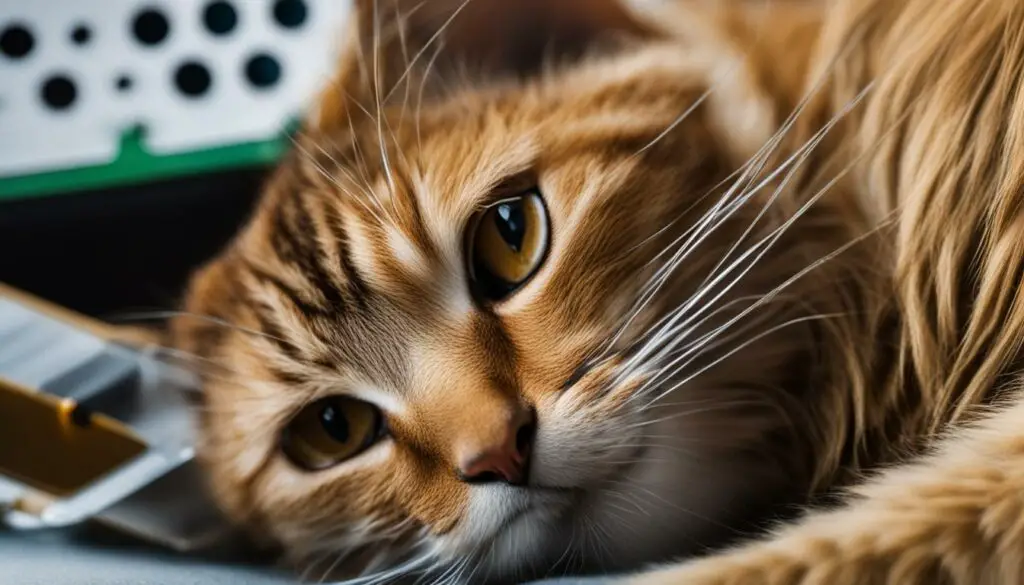
If you prefer natural or home remedies for cat fleas, there are alternative options you can consider. Some popular home remedies include giving your cat a flea bath using a reputable flea shampoo, as well as using a flea comb to manually remove fleas and their eggs from your cat’s fur. These methods can be effective in eliminating adult fleas, but it’s important to note that they may not address the entire flea life cycle or provide long-term relief.
When using any type of flea treatment, it’s essential to prioritize the safety of your cat and your family. Follow the recommended dosage, application frequency, and safety guidelines. Keep in mind that certain products may not be suitable for all pets, so consult with your veterinarian if you have multiple pets or if your cat has any existing health conditions. By choosing the right treatment and taking the necessary precautions, you can effectively treat and manage fleas on your cat’s face.
Home Remedies for Fleas on Cats
In addition to commercial products, there are also some home remedies that can help control fleas on cats. These remedies can be effective in conjunction with other flea control methods to provide relief for your cat and prevent further infestations.
Natural Flea Bath
A natural flea bath using a reputable flea shampoo can help eliminate adult fleas from your cat’s fur. Start by wetting your cat with warm water and lathering them with the flea shampoo. Massage the shampoo into their fur, paying attention to areas where fleas are most likely to hide, such as around the face, neck, and tail. Let the shampoo sit for the recommended time, usually about 5-10 minutes, and then rinse thoroughly. Be sure to follow the instructions on the shampoo bottle and avoid getting any soap in your cat’s eyes or ears.
Flea Comb
Using a flea comb is an effective way to manually remove fleas and their eggs from your cat’s fur. The fine teeth of the comb can catch fleas as you comb through your cat’s coat. Start by combing near the head and move towards the tail, paying close attention to areas where fleas are likely to hide. After each stroke, dip the comb into a bowl of soapy water to drown the fleas. This method can be time-consuming, but it is a non-toxic and chemical-free way to control fleas.
Environment Treatment
Treating your home environment is crucial in flea control. Vacuuming daily, especially in areas where your cat spends the most time, can help remove flea eggs, larvae, and pupae from carpets and furniture. Be sure to dispose of the vacuum bag or empty the canister outside to prevent reinfestation. Washing your cat’s bedding in hot water and using flea sprays or insecticides specifically designed for the house can also help eliminate fleas and disrupt their life cycle. Follow the instructions on the product label and treat all areas where fleas may hide, such as cracks, crevices, and baseboards.
| Home Remedies for Fleas on Cats |
|---|
| Natural flea bath using a reputable flea shampoo |
| Manually remove fleas and their eggs with a flea comb |
| Treat your home environment by vacuuming, washing bedding, and using flea sprays |
While these home remedies can be effective in controlling fleas, it’s important to remember that they may not completely eliminate a flea infestation. It’s always recommended to consult with your veterinarian for the best treatment plan for your cat and to ensure the safety and well-being of your pet.
Safety Precautions for Flea Treatment
When it comes to treating fleas on your cat, prioritizing safety is essential for both your furry friend and your family. Here are some important safety precautions to keep in mind:
1. Read and Follow Instructions
Always read and follow the instructions on the flea treatment product label carefully. Each product may have specific guidelines and usage instructions, so it’s crucial to adhere to them to ensure effectiveness and prevent any potential adverse effects.
2. Consult with Your Veterinarian
If you have multiple pets, it’s important to consult with your veterinarian before using flea treatment products to ensure they are safe for all animals in your household. Certain products may be harmful to species such as birds, fish, or reptiles, so professional guidance is crucial.
3. Consider Your Cat’s Sensitivities
Each cat may have different sensitivities and reactions to flea control products. Keep a close eye on your cat after applying a treatment and monitor for any signs of discomfort, irritation, or adverse reactions. If you notice anything concerning, consult with your veterinarian immediately.
4. Keep Products Out of Reach
Store flea treatment products in a safe place where your cat and children cannot access them. Some products may contain chemicals that can be dangerous if ingested or if they come into direct contact with eyes or skin.
By following these safety precautions, you can ensure that your cat receives effective flea treatment while minimizing any risks or potential harm. Remember, if you have any concerns or uncertainties, it’s always best to consult with your veterinarian for guidance tailored to your cat’s specific needs.
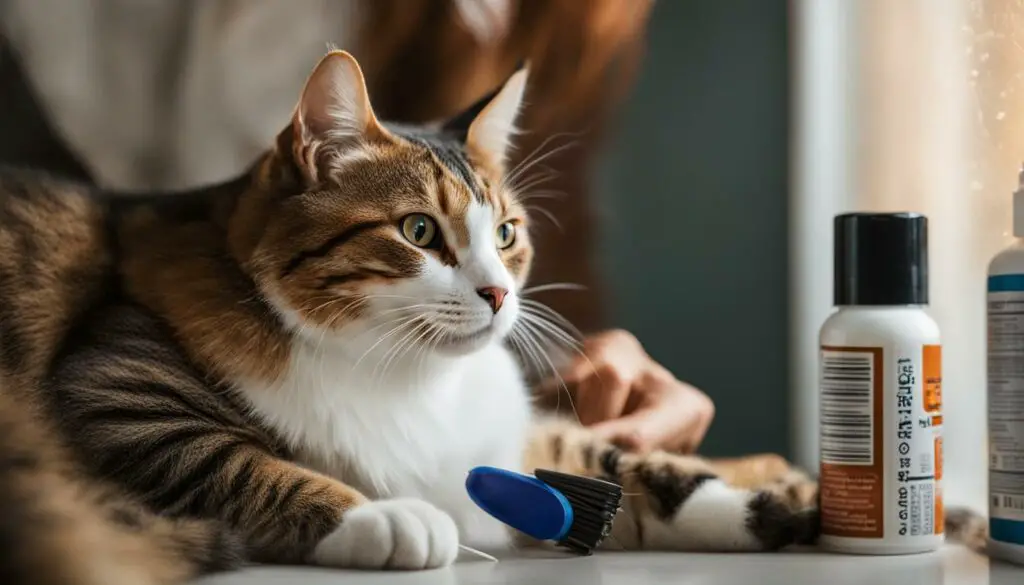
Identifying Flea Infestations
Flea infestations can be challenging to spot, as fleas are small and agile. However, there are several signs that can indicate the presence of fleas on your cat’s face. Keep an eye out for excessive scratching and grooming, as these are common symptoms of flea infestation. Additionally, you may notice the presence of flea dirt, which appears as small black specks on your cat’s skin. To confirm the presence of fleas, you can use a fine-toothed flea comb to comb through your cat’s fur, paying close attention to the face and neck area where fleas tend to gather. If you suspect a flea infestation, it is important to consult with your veterinarian to confirm the diagnosis and develop an appropriate treatment plan.
In addition to visual cues, it is also worth noting that cats with flea infestations may exhibit behavioral changes. They may become irritable or restless, and their appetite or sleep patterns may be affected. If you notice any of these signs along with the physical symptoms mentioned earlier, it is important to take prompt action to address the flea infestation.
Remember, timely identification of flea infestations is crucial in preventing further discomfort and potential health issues for your cat. By staying vigilant and taking proactive measures, you can help protect your feline friend from the nuisance of fleas.
Preventing Future Infestations
Once you have successfully treated your cat for fleas, it is important to take steps to prevent future infestations. This includes regular use of flea preventive products, such as spot-on treatments or flea collars, as recommended by your veterinarian. Maintaining a clean and hygienic home environment is also crucial. Regular vacuuming, especially in areas where your cat spends the most time, can help remove any potential flea eggs or larvae. Additionally, washing your cat’s bedding in hot water and using flea sprays or insecticides designed for the house can further prevent reinfestation.
Furthermore, it is important to minimize your cat’s exposure to other potential sources of fleas, such as other infested animals or environments where fleas are common. Avoid taking your cat to areas with high flea populations and be cautious when introducing new pets into your home. By following these preventive measures, you can help ensure that your cat remains flea-free and happy.
| Key Signs of Flea Infestation on Cats’ Face | Preventive Measures to Avoid Future Infestations |
|---|---|
|
|
By remaining vigilant and implementing these measures, you can effectively identify and address flea infestations on your cat’s face, ensuring their comfort and well-being.
Choosing the Best Flea Treatment for Cats
When it comes to choosing the best flea treatment for your cat, there are several factors to consider. Efficacy, safety, and convenience are key considerations in ensuring that the chosen treatment effectively controls flea infestations while keeping your cat’s well-being a top priority.
Topical spot-on treatments, such as Frontline and Advantage, are commonly used and can be obtained from your veterinarian. These treatments are applied directly to the skin and provide long-lasting protection against fleas and ticks.
If you prefer oral medications, options such as nitenpyram and spinosad provide fast-acting flea control. These medications are administered orally and begin killing fleas within hours. It’s important to follow the dosage instructions and consult with your veterinarian to determine the most suitable oral treatment for your cat.
Ultimately, the best flea treatment for your cat will depend on their individual needs and your preferences as a pet owner. Consulting with your veterinarian is crucial in selecting the most appropriate treatment option, as they can provide personalized recommendations based on your cat’s health, lifestyle, and any specific considerations or allergies.
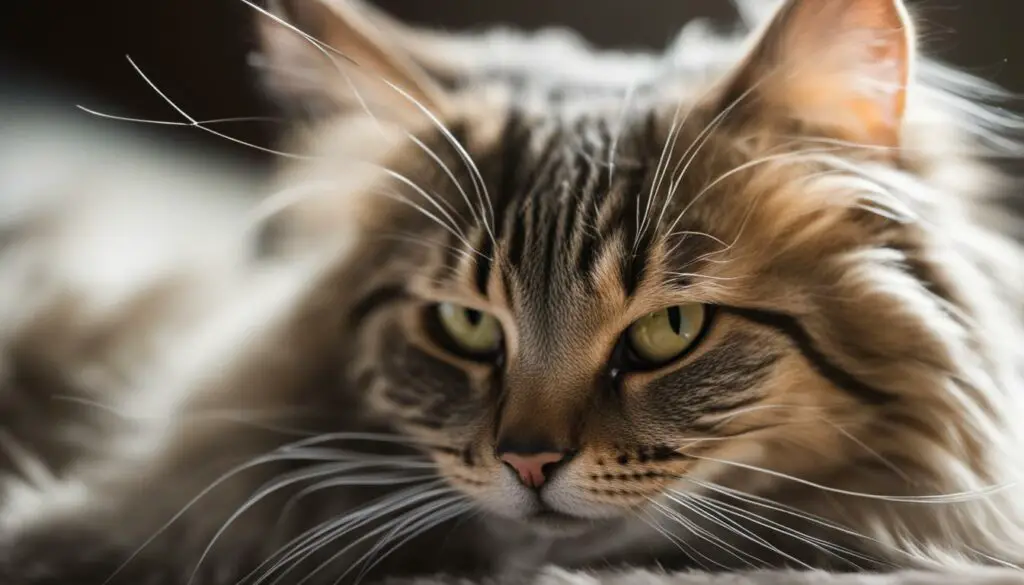
Comparison of Topical and Oral Flea Treatments for Cats
| Treatment Method | Efficacy | Safety | Convenience |
|---|---|---|---|
| Topical Spot-on Treatments | Highly effective in killing fleas and ticks | Safe when used according to instructions | Requires monthly application |
| Oral Medications | Fast-acting and provides quick relief | Generally safe, but may have some side effects | Usually administered as a single dose |
Table: Comparison of Topical and Oral Flea Treatments for Cats
Remember, flea treatment should be part of a comprehensive flea control plan that includes regular grooming, cleaning your home environment, and preventing future infestations. By choosing the best flea treatment for your cat and taking proactive measures, you can ensure their comfort and well-being.
Preventing Fleas on Cats
Fleas can be a persistent problem for cats, but with proper prevention measures, you can keep these pesky parasites at bay. Here are some effective strategies to prevent fleas on cats:
1. Regularly Apply Flea Preventive Products
Using spot-on treatments or flea collars specifically designed for cats can provide long-lasting protection against fleas. These products contain active ingredients that kill and repel fleas, preventing infestations. Follow the instructions on the product label and consult with your veterinarian to choose the most suitable option for your cat.
2. Maintain a Clean Environment
Regularly vacuum your home, paying close attention to areas where your cat spends the most time. This helps remove flea eggs, larvae, and pupae from carpets and furniture. Wash your cat’s bedding in hot water and use flea sprays or insecticides suitable for indoor use to eliminate any remaining fleas in your home.
3. Limit Exposure to Infested Animals and Environments
Avoid allowing your cat to interact with infested animals or visiting areas known to have flea problems, such as parks or outdoor spaces frequented by stray animals. Fleas can easily hitch a ride on your cat and infest your home. By limiting exposure, you reduce the risk of fleas finding their way onto your cat.

4. Consult with Your Veterinarian
Your veterinarian can provide valuable advice on flea prevention specific to your cat’s needs. They may recommend additional measures or products to ensure optimal protection against fleas. Regular check-ups also allow for early detection and prompt treatment of any flea infestations that may occur despite preventive efforts.
By implementing these preventive measures, you can minimize the risk of fleas on your cat and in your home. Remember, prevention is always better than dealing with a full-blown flea infestation.
Treating the Home Environment
Fleas are not just a problem for cats themselves, but also for their surroundings. To effectively control fleas and prevent reinfestation, it’s essential to address the home environment. Here are some key steps to take:
- Vacuum regularly: Daily vacuuming, especially in areas where your cat spends the most time, can help remove flea eggs, larvae, and pupae from carpets, rugs, and furniture. Pay close attention to cracks, crevices, and baseboards where fleas may hide.
- Wash bedding: Wash your cat’s bedding in hot water and dry it at a high temperature. This will help kill any fleas and their eggs that may be hiding in the fabric.
- Treat your home: In severe infestations, using flea sprays or insecticides specifically designed for the house can be necessary. Follow the manufacturer’s instructions carefully and treat all areas where fleas may hide, including floors, furniture, and pet resting areas.
By taking these steps, you can significantly reduce the flea population in your home and create a safer, healthier environment for your cat.
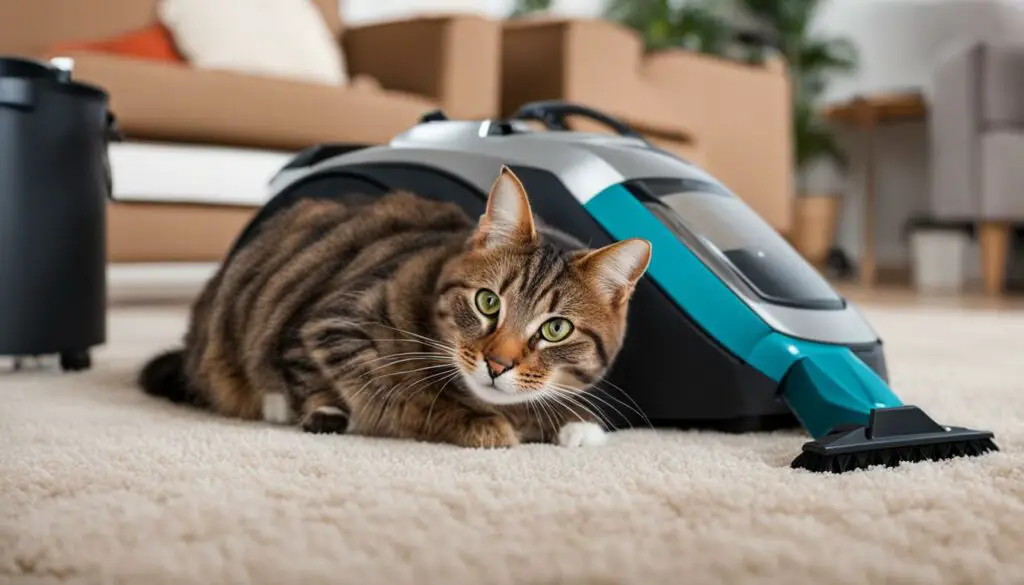
Table: Comparing Home Flea Control Methods
| Home Flea Control Method | Effectiveness | Ease of Use | Safety |
|---|---|---|---|
| Flea sprays or insecticides | Highly effective when used correctly | Easy to apply, but requires thorough treatment | May contain chemicals that can be harmful if not used properly |
| Vacuuming | Effective in removing flea eggs, larvae, and pupae | Simple and convenient | Safe for both cats and humans |
| Washing bedding | Eliminates fleas and their eggs from fabrics | Requires regular washing | Safe for both cats and humans |
Note: Always follow the instructions provided by the manufacturer when using flea control products and consult with your veterinarian for additional guidance.
Cat Flea Control: Finding Effective Solutions for Your Feline Friend
As a cat owner, dealing with fleas can be a frustrating and persistent challenge. While home remedies and over-the-counter products can often help manage mild infestations, severe flea problems may require professional pest control services. By understanding the different options available for cat flea control, you can make informed decisions to protect your cat and keep your home flea-free.
When it comes to treating cat fleas at home, there are several remedies you can try. Giving your cat a flea bath using a reputable flea shampoo can help eliminate adult fleas, while using a flea comb can help manually remove fleas and their eggs from your cat’s fur. Additionally, treating your home environment is crucial in flea control. Regular vacuuming, washing pet bedding in hot water, and using flea sprays or insecticides designed for the house can help eliminate fleas and disrupt their life cycle.
However, if your flea problem persists despite your best efforts, it may be time to consider professional pest control. Experienced exterminators have access to more potent insecticides and specialized equipment to eliminate fleas from your home effectively. They can assess the severity of the infestation, identify hidden areas of infestation, and develop a tailored treatment plan to eradicate fleas. By relying on professional expertise, you can ensure the comprehensive elimination of fleas and provide long-term relief for your cat.
In summary, cat flea control requires a multi-faceted approach. While home remedies and over-the-counter products can be effective for mild infestations, severe flea problems may necessitate professional pest control. By combining home remedies with thorough environmental treatment and seeking professional assistance when needed, you can effectively manage and eliminate fleas, providing your cat with a safe and comfortable living environment.
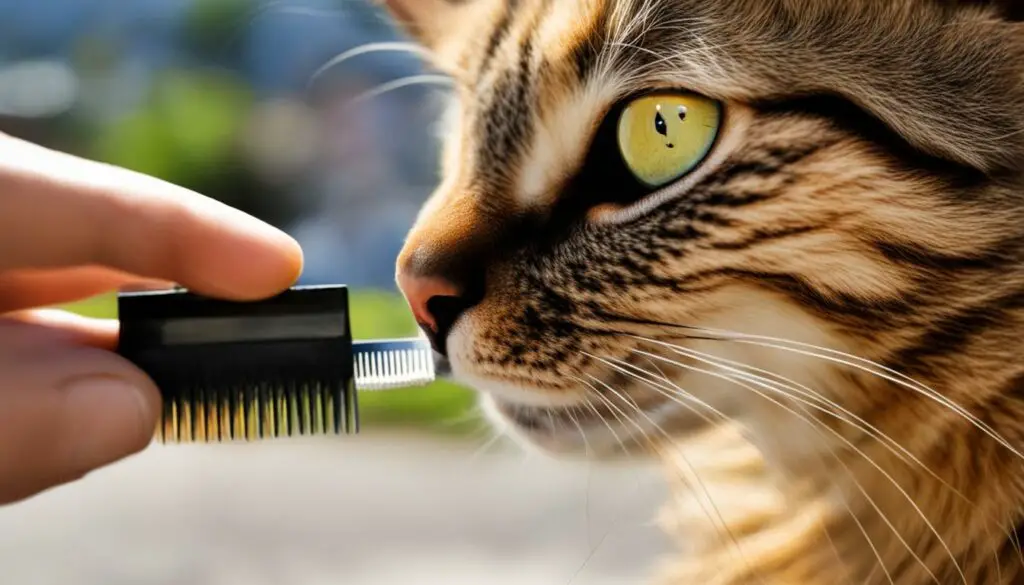
Table: Comparing Home Remedies and Professional Pest Control for Cat Flea Control
| Aspect | Home Remedies | Professional Pest Control |
|---|---|---|
| Efficacy | Effective for mild infestations | Highly effective for severe infestations |
| Convenience | Requires regular application and maintenance | One-time or periodic treatments |
| Expertise | No professional guidance required | Experienced exterminators provide tailored treatment plans |
| Product Access | Readily available over-the-counter | Access to more potent insecticides |
| Cost | Relatively inexpensive | Higher upfront cost but may provide long-term value |
Treating Persistent Flea Infestations in Cats
If you find yourself dealing with persistent flea infestations in your cat, it’s important to take action to effectively eliminate these pesky parasites. Despite your best efforts, some infestations may persist due to various factors. Here are some tips to help you address and treat persistent flea infestations:
1. Reassess your treatment methods
First, it’s crucial to reassess the treatment methods you’ve been using to control fleas on your cat. Evaluate whether the products you’ve been using have been effective in killing fleas and preventing their infestation. Consider switching to alternative products that contain different active ingredients or have a different mode of action.
2. Check your home for hidden infestation areas
Fleas can hide in various areas of your home, such as cracks, crevices, and baseboards. Thoroughly inspect your home for any potential hiding spots where fleas may be breeding. Vacuum these areas regularly and treat them with appropriate flea sprays or insecticides to eliminate any remaining fleas and disrupt their life cycle.
3. Treat all pets in your household
Fleas can easily spread among pets, so it’s essential to treat all animals in your household, even if they don’t show any signs of infestation. Cats, dogs, and other furry pets can carry fleas and contribute to the persistence of infestations. Consult with your veterinarian to ensure you’re using the most suitable flea treatment products for all your pets.
4. Consult with your veterinarian
If your efforts to control flea infestations are not yielding satisfactory results, it’s crucial to seek professional advice from your veterinarian. They can assess the situation, provide further guidance, and recommend alternative treatment options that may be more effective for your cat’s specific needs. Your veterinarian may also suggest additional measures to prevent future flea infestations.
By reassessing your treatment methods, addressing potential hidden infestation areas, treating all pets in your household, and consulting with your veterinarian, you can tackle persistent flea infestations and ensure the well-being of your cat.
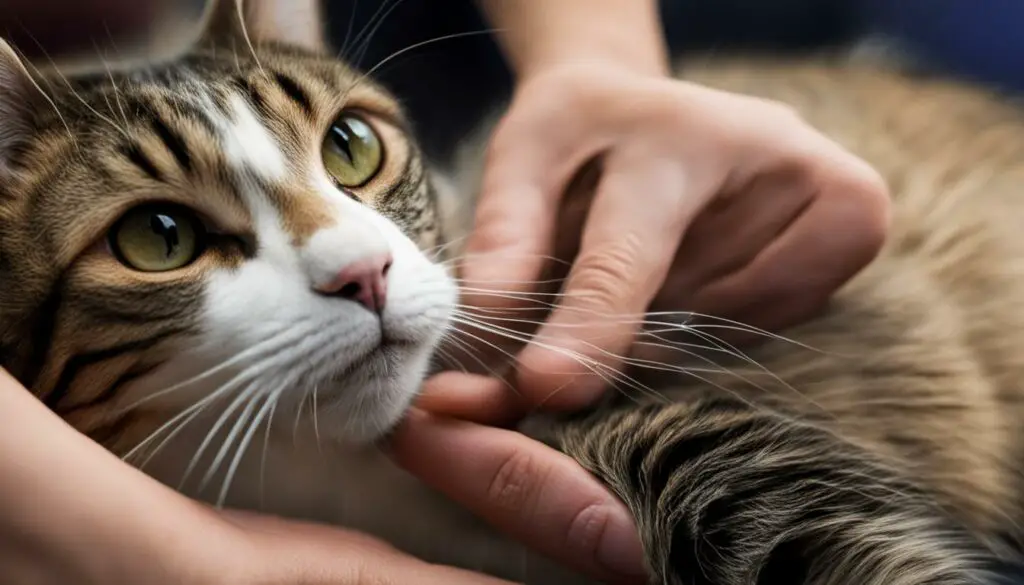
| Treatment Method | Pros | Cons |
|---|---|---|
| Topical spot-on treatments | – Easy to apply – Long-lasting effectiveness |
– Some cats may be sensitive to the product – Potential side effects like skin irritation |
| Oral medications | – Fast-acting flea control – No need for direct contact with the cat’s skin |
– May require frequent administration – Some cats may have difficulty swallowing pills |
| Flea baths | – Quick elimination of adult fleas – Can soothe itching and irritation |
– Flea baths may not provide long-lasting protection – Cats may not tolerate being bathed |
| Home remedies | – Can be cost-effective – Environmentally friendly |
– Limited effectiveness – May not completely eliminate infestations |
Table: Comparison of Different Flea Treatment Methods for Cats
Conclusion
In conclusion, dealing with fleas on a cat’s face requires a comprehensive approach that includes identifying, treating, and preventing flea infestations. By understanding the causes of flea infestations and their effects on cats, you can take the necessary steps to protect your feline friend.
When it comes to treating cat fleas, there are various options available, including shampoos, sprays, powders, and topical or oral medications. It’s important to choose products that contain insect growth regulators (IGRs) to prevent the maturation of flea larvae and follow the instructions provided.
Prevention is key in controlling fleas on cats, and regularly applying spot-on treatments or flea collars can help protect your cat. It’s also crucial to maintain a clean home environment by vacuuming regularly, washing pet bedding in hot water, and using flea sprays or insecticides designed for the house.
If you’re struggling with persistent flea infestations, it may be necessary to seek professional pest control services. They have the expertise and resources to effectively eliminate fleas from your home. Additionally, consulting with your veterinarian can help develop a more comprehensive flea control plan tailored to your cat’s specific needs.
Take charge of your cat’s flea control
Fleas on a cat’s face can be a nuisance, but with proper treatment and prevention, you can ensure the health and well-being of your feline companion. By staying vigilant and proactive, you can keep those pesky fleas at bay and enjoy a flea-free environment for both you and your cat.
FAQ
How do cats get fleas?
Cats can get fleas from other infested animals, such as dogs, or from the environment, such as infested bedding or furniture.
What are the effects of fleas on cats?
Fleas can cause excessive scratching, grooming, and skin infections in cats. They can also lead to allergies, anemia, and tapeworm infestations.
How can I treat cat fleas?
There are various treatment options available, including shampoos, sprays, powders, and oral or topical medications. Consult with your veterinarian for the best option for your cat.
Are there any home remedies for fleas on cats?
Yes, giving your cat a flea bath with a reputable flea shampoo and using a flea comb to manually remove fleas can help. Treating your home environment is also crucial.
What safety precautions should I take when treating fleas on my cat?
Read and follow the instructions on the product label, ensure it is safe for use on cats, and consult with your veterinarian if you have other pets or concerns.
How can I identify flea infestations in my cat?
Look for signs such as excessive scratching, grooming, and the presence of flea dirt (dried flea feces) on the skin. Use a fine-toothed flea comb to check your cat’s fur.
What is the best flea treatment for cats?
Topical spot-on treatments and oral medications are commonly used. Consult with your veterinarian to determine the most suitable option for your cat.
How can I prevent fleas on my cat?
Regularly apply flea preventive products, keep your home clean, and avoid contact with infested animals or areas. Consult with your veterinarian for additional tips.
How can I treat the home environment for fleas?
Vacuum daily, wash pet bedding in hot water, and use flea sprays or insecticides designed for the house. Address all areas where fleas may hide.
Should I consider professional pest control for fleas?
In severe infestations, professional exterminators can provide more potent insecticides and specialized equipment. Consult with reputable companies if needed.
What can I do if I have persistent flea infestations?
Reevaluate your treatment methods, consider seeking professional advice, and ensure all pets are treated. Consult with your veterinarian for a more comprehensive plan.
Source Links
- https://vcahospitals.com/know-your-pet/flea-control-in-cats
- https://www.goodhousekeeping.com/life/pets/a27199208/how-to-get-rid-of-fleas-on-cats/
- https://www.webmd.com/pets/cats/flea-prevention







